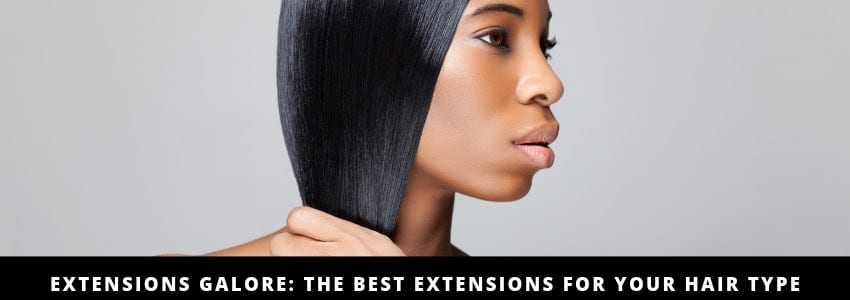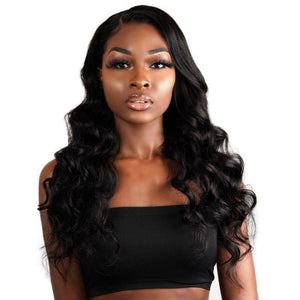It’s Raining Extensions!
There are
extensions for every occasion and every kind of hair! While any hair type can be conducive to extensions, to maximize your look and ensure a well blended, natural style one can use specific hair types.
Let’s Talk Hair Textures!
In hair world, at least to the untrained professional, hair was only thick or thin. Now, there’s hair ranging from 2A to 4C. Instead of purchasing more hair for a fuller look, though it always works, wigs have densities and varying textures. The extensions world has expanded, and with it so has our options. I know that I have had this issue especially, having fragile hair I have struggled with
natural hairstyles as well as extension styles for
thin hair. It’s hard when your extensions may show through your hair if you have wispy hair like me. And don’t think I’ve forgotten about my thick haired girls, I know it can be incredibly frustrating to have thick, luscious locks of hair and your extensions are thinner making it
difficult to blend. Additionally, it can be frustrating if you are used to thick hair and have to
buy up to five bundles to get the thickness you prefer.
Different Kind of Extension Textures
Peruvian
Remember when I talked about finding the right textured extensions for your hair type? Well, Peruvian is mine! When I started getting sew-ins, I initially would only purchase
Brazilian hair. At that time, it was like if you were wearing
virgin hair, Brazilian was the first and only choice. After I stumbled upon Peruvian hair, I decided to give it a chance. And it was the best hair decision I have ever made. Peruvian Hair is a little more expensive, but the investment is worth it. This hair has a silkier texture without compromising the bounce and touch of the bundles. For my installations, I usually get the standard three bundles and a closure or leave out. Peruvian blends so nicely with my leave out, and the wefts are not chunky. For thin or delicate hair textures, Peruvian is the way to go.
Brazilian
Brazilian hair still reigns supreme in the hair game.
People love Brazilian hair because of its versatility, price and availability at most
hair vendors, including Private Label Extensions, in body wave, straight and deep wave. Brazilian hair mimics the density of the most common hair types. Density is how thick or thin an individual's hair strands are. The standard density is 120% and is most commonly found in real hair and Brazilian hair, making it an automatic choice for women everywhere. Density can range from 80-180%.
Malaysian
Malaysian hair is excellent for those with thicker hair or a higher density. Fewer bundles are needed for Malaysian hair because it is more coarse and fuller than both Peruvian and Brazilian. Malaysian hair also holds a tighter curl and does not require much product to be maintained. Although this hair is more suitable for those with a higher density, I have had a positive experience with Malaysian hair. This hair was more natural to manage and dried quickly, which I enjoyed being a person who is super low maintenance when it comes to their hairstyles.
Microlinks/Fused
Microlinks or
Fused Extensions is a process where extensions bonded to individual strands of hair. There are two methods, cold fusion, and hot fusion.
Cold Fusion
Cold fusion is adhered to the hair twenty to thirty strands at a time by glue or keratin bond. It is pre-bonded hair, meaning that it is already a unit when attached to your head. This type of extension is also known to as Micro-Links. Micro linking involves sticking hair through a bead and adhering it to the hair. Cold Fusion can take from 4-6 hours to complete, and last approximately six months with proper care.
Best Hair Types to Use:
- Medium density hair
- Thick hair
Note: Individuals with fine hair may have a hard time covering the beading at the base of the micro link with cold fusion.
Hot Fusion
Hot Fusion is also known as a Keratin Bond. Keratin Bonding or Hot Fusion is close to the same process of Cold Fusion except for the addition of heat. Keratin U-tip bonds lined with silicone are attached to the hair using heating tools such as a flat iron or blow dryer. Hair is placed between the U-tip and bonded with a hot extension tool that melts the extensions tip to your hair. The silicone lining of the U-tip creates a barrier to
protect natural hair. The bonds are attached close to the root, leaving some space to allow natural growth of your hair. These keratin bonds packaged like “small bundles.” This method can take 2-6 hours and can last up to 4 months with proper care. Hair used in Hot Fusion techniques are non-reusable.
Best Hair Types to Use:
Note: thick haired people will benefit most from Hot Fusion.
Cost:
Micro-Linking, Cold or Hot Fusion can be costly. The lowest stylist that I have found for this style has been $200. The price varies on the kind of fusion used, how much hair covered and how long your natural hair is.
Clips-Ins
Clip-ins are wefts of extensions that have clips at the base to use to attach to the hair. They take the shortest amount of time, clipped in between parts of the hair. Clip-ins are temporary extensions and are reusable.
Best Hair Types to Use:
Clip-ins are best for extremely thick hair, due to the nature of the style, hair needs to be thick enough to cover the clips which can often be bulky and visible.
Cost:
Clip-in extensions cost can be extremely variable. These extensions can be DIY, and any hair, including store-bought hair, can be used to create these extensions.
Glue-ins
Glue-ins refer to the process of adding in tracks or extensions using hair adhesive or thirty-second glue. This method is done by adding adhesive along the length of a tracks weft and placing it on the hair, using light heat to seal the bond. This technique usually takes up to an hour or two, depending on if you are getting a cut and how long it takes your hair molding to dry.
Best Hair Types to Use:
This method has hair left out or all hair covered with an invisible part. It covers the majority of your natural hair making it suitable for all hair types. However, those with sensitive skin or
sensitive scalps may stray away from this method because of the harshness of the glue on skin.
Cost:
Glue-ins range from $45-$125 depending on the location and notoriety of the stylist.
Sew-ins
Sew-ins have gained popularity over the years due to their versatility, longevity, and ability to reuse the hair. However, be careful with the tension form the braids and weight of extensions when it comes to your hair. Sew-ins take about one to three hours for
installation. They can last up to two months with the proper care but should be maintained or taken down to preserve the integrity of your natural hair. Sew-ins have become my personal favorite because, for the most part, I can manipulate it like real hair and tuck all my hair away if need be.
Best Hair Types to Use:
All hair types! Whether you rock your
installation with leave out, closures or a frontal, sew-ins can work for any hair type.
Join The Hair Extention Gang
Extensions are fun and can provide you with many different styles, do not be afraid to
switch it up and try new things. There are many ways to go about
getting them installed such as micro linking, glue-ins, sew-ins, and clip-ins. All are fabulous choices as long as you stay informed about proper hair and extension care!


